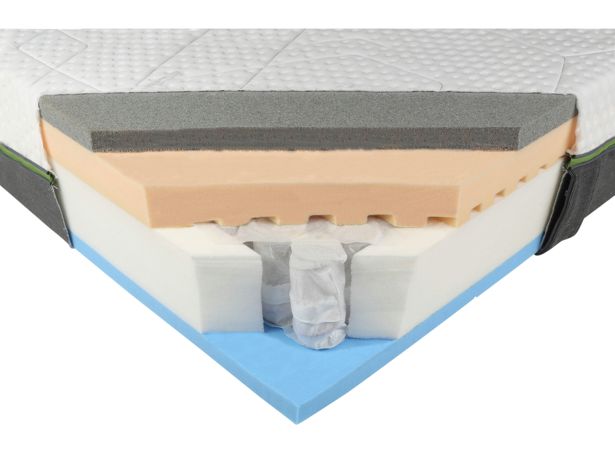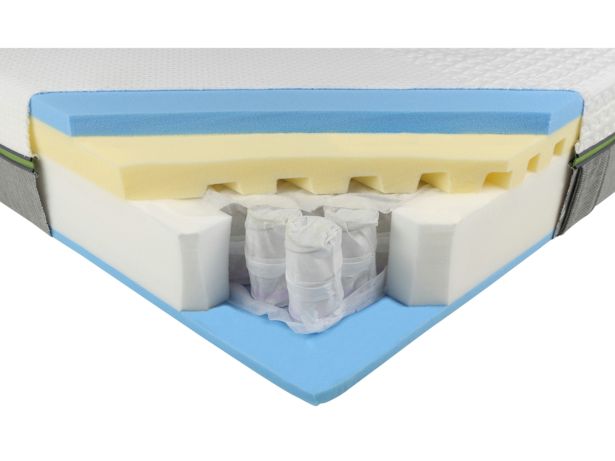By clicking a retailer link you consent to third party cookies that track your onward journey. If you make a purchase, Which? will receive an affiliate commission which supports our mission to be the UK's consumer champion.
How to clean a mattress

Whether there's a stain or smell you want to remove or you just want to give your mattress a regular spring clean, these tips will help you get it right.
Use our expert Which? guide to discover the best way to clean your mattress in just six simple steps. Plus, find out how to remove common mattress stains such as blood and urine, and keep your mattress feeling fresher for longer.
Mattress past its best? Head to our round-up of the best mattresses to find a new one.
How to clean your mattress

If your mattress is stain-free, it should be quick to clean. Simply follow these six steps:
- First, check the instructions or care label for your particular mattress.
- Strip the bed and check for new stains on the mattress. If you find any, scroll down for tips on how to tackle them
- Gently vacuum the surface of the mattress. For this, you should use the upholstery attachment on your vacuum cleaner, making sure the attachment is clean before you begin. Once you've given the mattress the once over, go back and focus on any nooks and crannies in the surface to make sure you pick up every last bit of dust and dead skin. It's a good idea to vacuum under the bed to remove dust at the same time, especially if you suffer from allergies
- Rotate your mattress from head to toe if it's one-sided. If it's two-sided, flip it and make sure you vacuum both sides of the mattress
- Air your mattress for a few hours to let the fabric breathe. Unless you need to get rid of an unpleasant smell (see step five), opening the bedroom window to let fresh air circulate around the room and pass through the fabric in your mattress should be sufficient
- Remake the bed. We recommend using a mattress protector beneath your sheet to protect your mattress from dust and sweat, as this means you won't have to clean the mattress so often.
See our guide to how often you should wash your bedding.
Cleaning a memory foam mattress

Always check the manufacturers instructions before attempting to clean your memory foam mattress. They often come with a removable mattress cover that's machine washable, but not always. A removable cover can make cleaning a lot easier, but there are a couple of things to be aware of.
Always check the manufacturer’s instructions and the details of your mattress warranty before cleaning. Some mattresses have removable covers, but the manufacturer actually advises against taking the cover off and washing them, while others allow this but say to avoid cleaning the foam after the cover has been removed.
If you're putting your cover in the washing machine, follow the washing instructions carefully to be sure you don’t inadvertently invalidate your warranty or shrink the cover so much it doesn’t fit back over the mattress.
If you’re tempted by memory foam, take a look at our best memory foam mattresses.
Video: how to remove mattress stains
Our handy video shows you at a glance how to tackle stains, or read on for more detailed information.
Scrubbing stains out of a mattress is no one's idea of fun, but it's essential if you want to keep yours clean and odour-free for years to come. Before you get going, there are three golden rules to follow:
- Try to attack stains as soon as possible
- Always check the mattress label before you apply any cleaning products
- Test any cleaning solution on a small part of the stain first to ensure it won't damage the mattress.
How to get blood stains out of a mattress
To get blood stains out, first dab at the stain with a little cold water. Be careful not to soak the mattress and don't rub the stain as this could spread the blood further.
You might find this technique surprisingly effective, especially if the stain is recent, but if not, try adding a little baking soda to the water. Apply to the stain, leave it for 30 minutes, then dab with clean water and leave to dry.
If the stain is still there after the mattress has dried, try following the steps below for removing urine, as these will also work for blood.
How to get urine out of a mattress
To remove bodily fluids such as urine from your mattress, try diluting washing-up liquid in water and then gently dabbing at the stain with a cloth or sponge. Remember that mattresses aren't waterproof, so it's best to clean slowly and steadily.
If the stain still isn't lifting, and your mattress care label says it's OK, use an upholstery cleaner – but always read the instructions. We recommend erring on the side of caution, so it's safest to dilute it and avoid spraying it directly on to the mattress.
Removing other mattress stains
For food and drink stains such as tea and coffee, your best bet is to try the baking soda and cold water mix mentioned above.
For bodily fluids and sweat stains, try using diluted washing-up liquid. If in any doubt, though, contact the manufacturer to find out if it has any specific advice.
For advice on upholstery cleaners, see our guide to the best stain removers for clothes and fabrics.
How to stop your mattress from smelling

Regardless of how comfortable your mattress is, you're unlikely to get a good night's sleep if you're unable to escape an unpleasant smell when you put your head down.
There are two reasons your mattress might smell:
1. The mattress is brand new.
It's not uncommon for mattresses made with synthetic materials such as memory foam to have a strong chemical smell when you first unpack them. But even if your mattress isn't synthetic, you might find it smells a bit when new as a result of the flame-retardant chemicals that manufacturers are required to apply by law.
The smell should disperse gradually, but you can speed up the process by leaving it near an open window to air. Find out more about how to improve your indoor air quality at home.
Or, if the smell is especially strong, you can try airing the mattress outside if you have a patio and the weather is good.
New mattresses should be unwrapped immediately. Don’t leave any plastic wrappings on and don’t leave it in your garage for a week, as the damp could lead to rot.
2. Something has soaked into the mattress's fabric cover
Bodily fluids are obvious examples, but drinks such as tea and coffee can easily be spilt if you're enjoying breakfast in bed. Even spilt water can give the mattress a musty smell if the fabric hasn't been properly dried out.
After you've removed any stains, air the mattress for as long as possible to allow the smell to fade. If the smell is especially strong or unpleasant, though, you'll need to resort to other measures. Sprinkle baking soda over the entire mattress surface and leave it for as long as possible, ideally overnight. Next, vacuum up the baking soda and leave the mattress to air by an open window – you should find the smell has gone.
If the smell still hasn't gone and you've had your mattress for a while, it might be time to replace it.
Need a new one? See our round-up of the best mattress deals.
Why do mattresses need regular cleaning?
No matter how often you change your bed linen, you still need to go the extra mile every so often and give your mattress a thorough clean.
According to The Sleep Council:
- The average adult loses 285ml of fluid each night
- An average bed contains 10,000 dust mites that produce more than two million droppings, which can aggravate allergies
- We shed around 454g of dead skin over the course of a year, much of which ends up nestled in your bed
- A person spends roughly a third of their life in bed.
It's no wonder The Sleep Council says that a dirty mattress can contain worrying levels of staphylococcus, enterococcus, norovirus and even MRSA.
So, while you might think your mattress isn't dirty, especially if you normally shower before going to bed and if the mattress is stain-free, that's unlikely to be the case.
Unwelcome visitors in your bed? Read our advice on how to get rid of bedbugs.
How often should you clean your mattress?
There's no hard and fast rule for how often they need to be cleaned. It all depends on the mattress and the person sleeping on it, but every six months is advisable.
If you're in the habit of flipping or rotating your mattress every three to six months (as you should be), it's worth taking a little extra time to clean it while you do so.
If you suffer from allergies, you should clean your mattress whenever the tell-tale symptoms of a runny nose, itchy throat and dry eyes start to worsen.
It also depends on how breathable the mattress is. Every mattress we review is tested for how well moisture passes through it – the more breathable a mattress is, the less likely it is to stockpile sweat.
Head to our mattress reviews to find a breathable option.
How to make your mattress last longer
Make your mattress go the distance with these expert tips from The Sleep Council.
- Give the mattress some air Get into the habit of airing your mattress daily. Throw back your duvet and pillows in the morning (you can leave the mattress cover on) and leave the bed to air for 20 minutes. This will allow body moisture to evaporate out.
- Turn your mattress regularly, but only if the manufacturer advises it. You should turn your mattress over and rotate end-to-end every week for the first three months, then every three or four months after that. This will help the upholstery fillings to settle down more evenly. Some mattresses, particularly memory foam or those with in-built toppers, shouldn’t be be turned over, but you should still rotate them regularly.
- Ban bouncing on the mattress (fun though it is) and try not to sit on the edge of the bed too much. Both can put undue strain on the mattress and cause it to lose support sooner.
- Protect the mattress with a mattress protector A washable cover will protect your mattress from stains and you can also buy covers made from purpose-made ‘barrier’ fabric if you have a dust allergy.
- Use your mattress guarantee Think your mattress has sagged sooner than should be expected? Consider contacting the retailer or manufacturer. Often they will come with a warranty to cover faulty materials or shoddy workmanship. Unfortunately, most mattress guarantees won't cover the gradual wear and tear that happens and which leads to a loss of support.
- Consider using a mattress topper You can pick one up for as little as £10 – although some can cost more than £100 – and add an extra layer of memory foam or padding to the top of your mattress. The quality can vary significantly, though, so it's worth checking our full review of the best mattress topper brands before you buy.
Find out more about the benefits of mattress toppers in our guide to the best mattress toppers.
This article uses insights from the Which? Connect panel, collected from research activities with our members. Find out how to get involved



